Millipedes in carrots and sweet potatoes
Learn about identification, biology, monitoring, thresholds and best management practices for millipede control in carrots and sweet potatoes.
Millipedes are generally considered beneficial in vegetable production systems because they feed on decaying plant material, which helps incorporate organic matter into the soil. However, under certain conditions, millipede populations can build to high levels and may damage the roots and seedlings of a variety of crops. In recent years, millipedes have become an increasing problem in Ontario root crops, particularly carrots and sweet potatoes. Millipede damage has recently been observed in ginseng seedlings and is increasing in field corn grown under no- or low-till cultivation.
Identifying millipedes
Millipedes (Figure 1) are often confused with other arthropods commonly found in soil, such as wireworms (Figure 2) and centipedes (Figure 3). Millipedes have elongated, cylindrical bodies that range in length from 1-10 cm at maturity. They range in colour from white to grey-black and tend to coil up into a tight spiral when disturbed. They have numerous, uniform body segments. The number of segments varies with species and increases with age. Their most distinguishing feature is their many legs. They have two pairs per body segment (Figure 4).
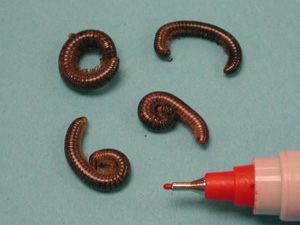
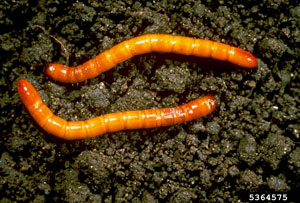
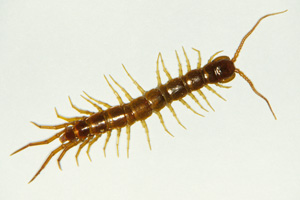
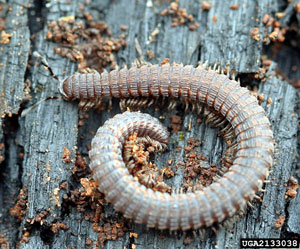
Centipedes are usually yellow to reddish brown and have flatter bodies than millipedes. Unlike millipedes, they have only one pair of legs per body segment. Centipede legs are generally longer and tend to stick out along the sides of their bodies.
Wireworms only have three pairs of legs, all located on the thorax (Figure 5).
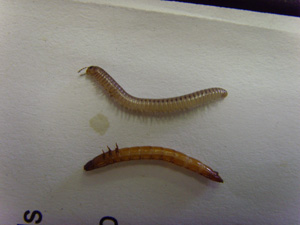
There are approximately 10,000 known species of millipedes worldwide, however only three species have been implicated as damaging Ontario root crops — Cylindroiulus caeruleocinctus, Blaniulus guttulatus and Pseudopolydesmus spp..
The first two species belong to a group called julids, sometimes referred to as snake millipedes. They have a typical millipede appearance — a cylindrical body and rounded head used for ramming through the soil. The two julids can be distinguished by their colour — C. caeruleocinctus is dark brown or black (Figure 6) while B. guttulatus (the spotted snake millipede) is much lighter (white to yellow) with red spots running down the side (Figure 7).
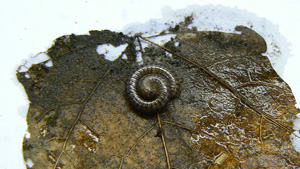
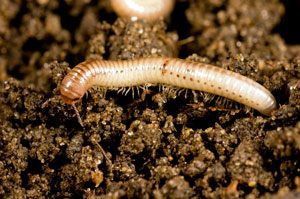
The third species, Pseudopolydesmus, has a flatter body shape with distinct body segments (Figure 8).
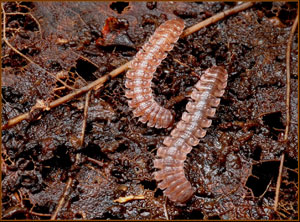
Biology and behaviour
Millipedes, sometimes called millepedes or millipeds, play an important ecological role by breaking down organic matter in a variety of environments. Although the majority of the 10,000 known species of millipedes are beneficial, certain species are pests of crops, including potatoes, sugarbeet, carrots, sweet potato, cole crops, strawberries and peas and beans.
Millipedes belong to a class of soil arthropods that have two pairs of legs on each body segment. As they grow, millipedes increase their length by adding body segments. With each additional segment come two pairs of new legs. In temperate regions, they range in length from 1–10 cm; in the tropics, they can be as long as 28 cm. Similar to insects, millipedes grow and mature with successive moults. C. caeruleocinctus has 14 moults, while B. guttulatus has 11.
In Ontario, most millipedes lay clusters of 20–300 eggs in nests buried in the soil. From the time of egg laying in the spring or early summer, it takes millipedes at least a year and half to achieve sexual maturity. Some species, like C. caeruleocinctus and B. guttulatus can live from 2–5 years.
Millipedes are typically nocturnal, feeding at night. Many report that millipedes prefer humid, moist environments to reduce the risk of desiccation. However, research from around the world shows millipedes can be active and damaging to the roots of crops during periods of drought when the only source of moisture may be the crops themselves.
Millipedes have their own unique self-defence mechanisms. They don't bite or sting, but release chemicals when disturbed or crushed.
The type of chemical defence compound released depends on the type of millipede. For example, julid millipedes (e.g., C. caeruleocinctus) produce quinones while some polydesmida millipedes produce cyanogenic compounds. These fluids are generally not toxic to humans but can be dangerous to the eyes and may produce allergic reactions in sensitive people. They are also responsible for the distinctively unpleasant odour commonly associated with dead millipedes.
Monitoring
Start sampling for millipedes in the spring, just before or shortly after seeding carrots or transplanting sweet potato slips. Research conducted in Ontario in 2007 found that pitfall traps were the most effective method of trapping millipedes early in the season. As the season progressed and plant canopies filled in, more millipedes were captured in the corn bait traps. Buried cut potato bait traps were also evaluated but were the least efficient at trapping millipedes of the three traps. For all trap types, place individual traps at 10-20 marked sites in a Z or W pattern across the middle of the field, with traps placed at least 10 m away from the field edge. This will provide a relative measure of field populations. Monitor populations for 2 consecutive weeks or more.
Pitfall traps
To make a pitfall trap, bury a plastic cup so that the rim of the container is just above the soil surface, to help prevent rainwater from filling the cup (Figure 9). Partially fill the cup with non-poisonous, mammal-friendly antifreeze, which acts as a preservative. To protect the trap, construct a roof or canopy above it, using a plastic lid from a dairy container and two pieces of galvanized wire (Figure 10). Remove and replace pitfall traps with new cups and antifreeze weekly.
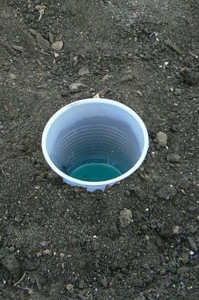
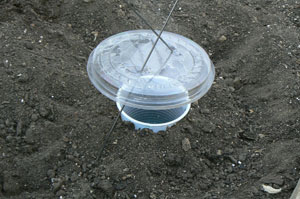
Corn bait traps
To make a corn bait trap, place a 1/4 cup of untreated corn seed into a fine, mesh pouch (Figure 11). Soak the pouch in water for at least 12 hours before burying it approximately 15 cm deep at flagged locations. To avoid problems with rotting corn, replace bait traps every 3-4 days.
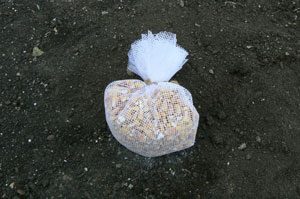
Thresholds
Thresholds have not been established for millipedes in horticulture or field crops. Further research in Ontario is required to determine the number of millipedes in sweet potatoes and carrots that leads to economic losses.
Based on preliminary sweet potato data, finding 5-10 millipedes in at least half the traps or more than 20 millipedes in two or more traps, during a monitoring period, warrants further investigation - trapping later in the season and/or examining sample roots later in the summer (late August to early September) for scraping, holes, tunnels or other signs of damage.
Best management practices
Since millipedes have not been previously recognized as a pest of root crops in Ontario, there is very little information available on how to manage them. Chemical control is not an option, as there are currently no pesticides registered for use against millipedes in any field or vegetable crop in Canada.
In fields where pre-season monitoring suggests millipede populations are high, early tillage prior to planting may help bring millipedes to the surface where they are susceptible to desiccation and predation.
If monitoring during the field season suggests that populations are high, harvest as early as possible, because millipedes will continue to feed on crops as long as they are in the soil. Remove crop residue after harvest rather than leaving it in the field to reduce additional food sources and possible overwintering sites.
Generally, millipede populations are thought to do best under cool, moist conditions. Avoid practices that increase soil moisture above that required by the crop. (Note, however, that even though 2007 was a dry season, high populations of millipedes in carrot and sweet potato fields were found.)
It is important to start monitoring and documenting millipede activity in Ontario root crops. Information on seasonal dynamics, crop rotations, soil type, soil moisture, damage assessments and crop varieties will prove valuable in the development of best management practices for destructive millipedes. If you suspect millipede activity or damage in your root crops, monitoring will help determine how to respond.